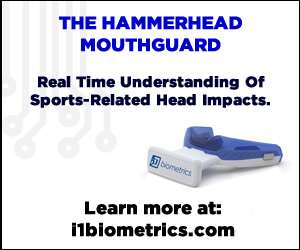Concussion Signs/Symptoms/Severity
Myth: All concussions are the same.
Fact: No two concussions are identical. The symptoms can be very different, depending on a variety of factors, including the degree of force and location of the impact, the degree of metabolic dysfunction, the tissue damage and recovery time, the number of previous concussions sustained by the athlete, and the time between injuries. They do, however, share certain characteristics.
Myth: A concussion occurs only when an athlete experiences a loss of consciousness (LOC).
Fact: Concussions can occur with or without LOC. In fact, the vast majority of concussions (more than 95% in a recent study of concussion among high school athletes)[5] do not result in LOC. As recently as 2007, 42% of youth coaches still believed that a concussion only occurred when an athlete loses consciousness. However, in a later study of parents of young rugby players published in 2009, 95% reported that a player did not need to be knocked out to have been concussed, suggesting that efforts to dispel this myth may be working. [5]
Myth: There is a direct relationship between the presence and duration of LOC and concussion severity.
Fact: A brief LOC does not necessarily correlate with concussion severity, despite the fact that it is associated with early neuropsychological deficits. Historically, LOC was thought to be a hallmark of a more serious, severe concussion, with athletes who lost consciousness at the time of their concussion receiving a higher "grade" of concussion (Grade 2 or 3) than those that did not, and athletes who were knocked unconscious for longer periods of time receiving higher grades than those who never lost consciousness or were unconscious for shorter periods of time (Grade 1). These grades were used to determine how long an athlete should be removed from sports after sustaining a concussion.
Clinicians involved in the assessment and management of sport-related concussions, however, began to notice that athletes who were knocked unconscious for brief periods of time often recovered more quickly than those who did not lose consciousness at all. Therefore, it seemed inaccurate to diagnose those who did not lose consciousness with a lower grade of concussion.
Furthermore, using concussion grade to determine the period of time that an athlete was removed from sports fell out of favor. It did not make sense to keep those who recovered more quickly out of sports for longer periods of time than those who recovered more slowly. For this and for several other reasons, the use of grading systems has been largely abandoned.
Nowadays, when making decisions to return an athlete back to play after he or she has recovered from a sport-related concussion, doctors consider each case individually, taking all factors into consideration in helping to determine the amount of time an athlete is asked to remain symptom free before returning to contact, with the most recent consensus of experts viewing prolonged LOC as a red flag for concussion and a factor that may modify concussion management.
Myth: Temporary confusion or even a permanent gap in memory
Fact: Loss of consciousness is not necessary for there to be the immediate, but temporary, change in brain functions, including PTA, which characterizes a concussion.
Myth: A player who gets "dinged" (sustains a blow to the head resulting in a stunned confusional state that resolves within minutes) hasn't suffered a concussion.
Fact: This is one of the biggest concussion myths. Even today, with all the attention on concussions, Safe Kids Worldwide found in a 2012 survey [11] that half of all coaches surveyed believe there is an acceptable amount of head contact (i.e.,getting their bell rung, seeing stars) young athletes can receive without potentially causing a serious brain injury.
A stunned confusional state is considered a concussion even though the symptoms may only seem to last for a very short time. Because the signs and symptoms of concussion may not be apparent until several minutes or hours later, with delayed onset of symptoms more common in athletes under age 18, it is essential that a player who has gets dinged be re-evaluated frequently to check to see if a more serious injury has occurred, especially during the first three hours, with a follow-up clinical evaluation and symptom checklist performed at 24 hours post-injury.
Myth:The signs and symptoms of concussion are always apparent immediately after injury.
Fact: While signs of concussion (those characteristics that can be observed by people other than the athlete) and symptoms (experienced and reported by the athlete him or herself) are often present or observable at the time of injury, they may not appear until several hours or even days or weeks later. In fact, delayed onset of signs and symptoms is more likely in younger athletes. Athletes, parents and other caregivers thus need to be alert to the occurrence of such delayed signs or symptoms or deteriorating mental status, which may signal the presence of a serious, life-threatening brain injury, such as subdural hematomas (bleeding on the brain).









